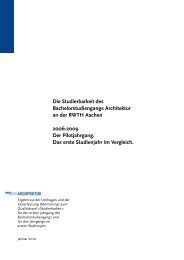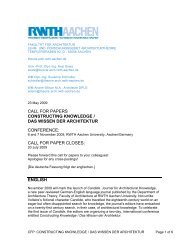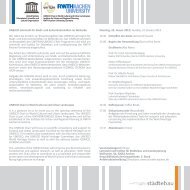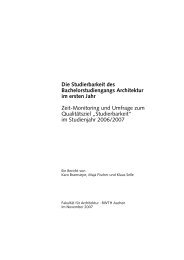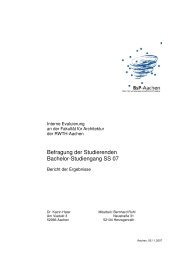Gutachten Dresden_englisch_dritte f.indd - Fakultät für Architektur ...
Gutachten Dresden_englisch_dritte f.indd - Fakultät für Architektur ...
Gutachten Dresden_englisch_dritte f.indd - Fakultät für Architektur ...
You also want an ePaper? Increase the reach of your titles
YUMPU automatically turns print PDFs into web optimized ePapers that Google loves.
as the effect of diffuse winter light which hinders visibility, the Waldschlösschen Bridge<br />
does not disturb the view from several of the vantage points under study. Nevertheless,<br />
there are several important vantage points which were used to dramatic effect in the<br />
past, and which form part of the individual character of this cultural landscape. These<br />
include the stations along the valley routes on either side of the Elbe river bend, which<br />
create a series of sequential impressions of the landscape culminating in a magnificent<br />
experience of the landscape today, which would be considerably compromised in future.<br />
The same holds true for legendary vantage points important to the arts, such as the<br />
view from the Waldschlösschen itself, where the <strong>Dresden</strong> skyline would be framed by<br />
the Waldschlösschen Bridge rather than the Elbe meadows, and where the view into<br />
the distant parts of the Elbe valley would also become alien. Night views from various<br />
directions and vantage points would be equally disturbed, as a source of bright artificial<br />
light would be created in the relatively unlit Elbe river bend.<br />
But the most decisive factor in this summary statement from the point of view of the<br />
assessors is the third observation:<br />
3. The Waldschlösschen Bridge cuts into the cohesive landscape of the Elbe river bend<br />
at its most sensitive point, splitting it irreversibly into two halves.<br />
The actual view and the immediate experience of this area, together with current aerial<br />
photographs and historical maps, establish the uniqueness of the Elbe river bend with<br />
the Elbe meadows between Albert Bridge and Loschwitz Bridge. Comparative analyses<br />
of inner-city river landscapes in other large European cities further demonstrate the<br />
unique character and great value of this cohesive cultural landscape. In this section of<br />
the landscape, the Elbe floodplains have remained intact in their totality, and together<br />
with the Neustadt Elbe meadows and the Elbe area between Loschwitz and Pillnitz,<br />
they represent a cultural landscape of outstanding importance, which is why almost the<br />
entire section of the Elbe valley within the <strong>Dresden</strong> urban zone was inscribed on the<br />
World Heritage List, not only the inner city area or individual architectural sites or parks.<br />
The Elbe meadows here form a virtually unobstructed flood plain area with trees<br />
scattered only here and there, creating a unique impression of open space in the middle<br />
of the <strong>Dresden</strong> metropolitan area. However, this effect can only come about where the<br />
view dos not immediately encounter obstructions. The striking effect of this landscape<br />
view is lent additional force by the shape of the bend in the valley, as the architectural<br />
features of the neighbouring areas retreat into the background, and the impression of<br />
endless distance arises. Providing a singular frame to this view of the Elbe meadows<br />
is the predominantly green backdrop of the north slopes of the Elbe, where the Elbe<br />
castles with their gardens and vineyards appear.<br />
111






